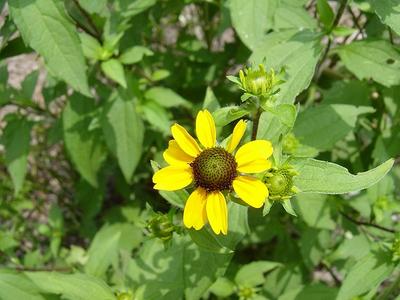She sent me these pictures to consider. I think it's Brown-eyed Susan (Rudbeckia triloba). I told her I'd put the photos on the blog to see if any of my more knowledgeable plant friends had any better ideas.
Here's a close-up of the bloom:

And here's a view of the whole plant:

If you look closely at the base you can see the triloba part.
Compare here, here, and here.
You can take a virtual tour of the Ecoscape, or browse the Alabama meadow wildflowers.
We had a frost last night so this might be the last flowers here for a while!


8 comments:
Flakes of snow have been drifting downwards here.
I think you're right, though it's hard to see just how pronounced and conical the eyes on your Rudbeckia are. I was trying to figure out the subspecies, and think rupestris is a good guess, but I could well be wrong.
And Tami's right--black-eyed are more common, but that's R. hirta as opposed to R. triloba (as though I could tell the difference without a very good key). Both are native all over the place.
Without the flower in hand, I am leaning toward Rudbeckia laciniata (Tall Coneflower) because of the greenish yellow disk flowers. R. triloba has deep purple-red disk flowers as does the other flower with lobed leaves which is R. subtomentosa (Sweet Coneflower). According to my regular source book, R. triloba also has orange at the base of the ray flowers.
Don't worry about the frost. We've had two hard frosts and I still found over 100 species of wild flowers in bloom last week. (Check out my web page if you are interested.)
http://www.deanswildflowers.com
I think the technical name for the flowers is yellow flower..
OW they came across more green here than in the original picture I think... They really are fairly dark centers.
I'm hoping Wayne will weigh in sooner or later...
I'm sorry it took so long, Karen. It's nice to see so many folks knowledgeable about Rudbeckia!
I'm afraid I can't tell from the pics, but here's some info. There are 28 species of Rudbeckia, according to USDA Plants. Somewhere around 12 are suspects.
I've found a key that distinguishes between the following: R. fulgida (orange coneflower), R. heliopsidis (sun-facing cf), R. hirta (black-eyed susan), R. laciniata (cutleaf cf), R. mollis (softhair cf), and R. triloba (brown-eyed susan).
Of those above species, if you're convinced that the lower leaves are deeply lobed, then that's it: R. triloba.
The remaining ones that I don't have a key for are:
R. auricula (eared cf), R. bicolor (pinewoods cf), R. grandiflora (rough cf), R. mohrii (Mohr's cf), and R. nitida (shiny cf).
So there's the possibility that it could be one of those in the latter list, but of the ones in the top list your description matches R. triloba.
Neat. Now I want all the Rudbeckias.
Sorry - that URL is for USDA Plants Database.
Post a Comment